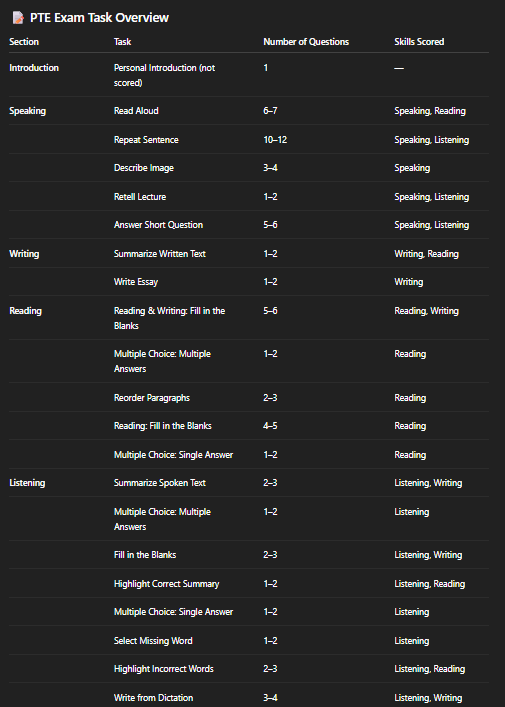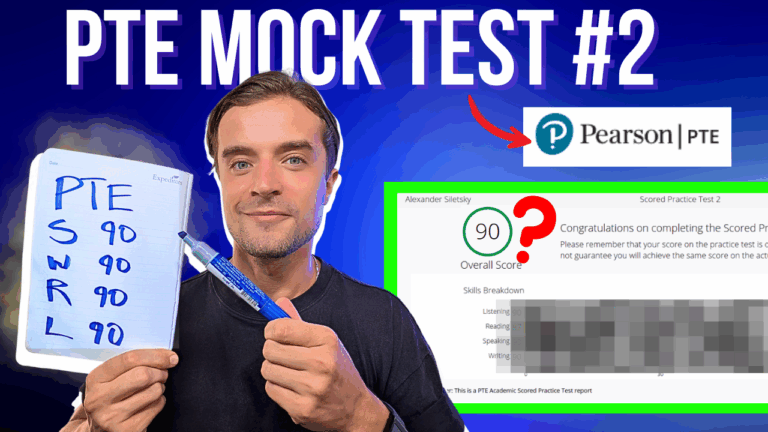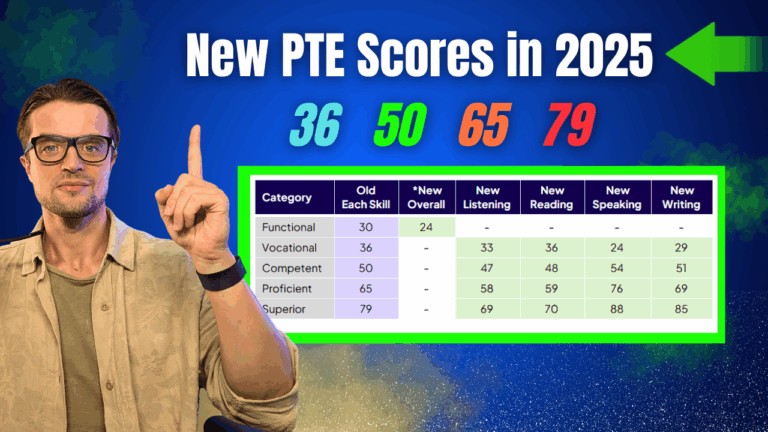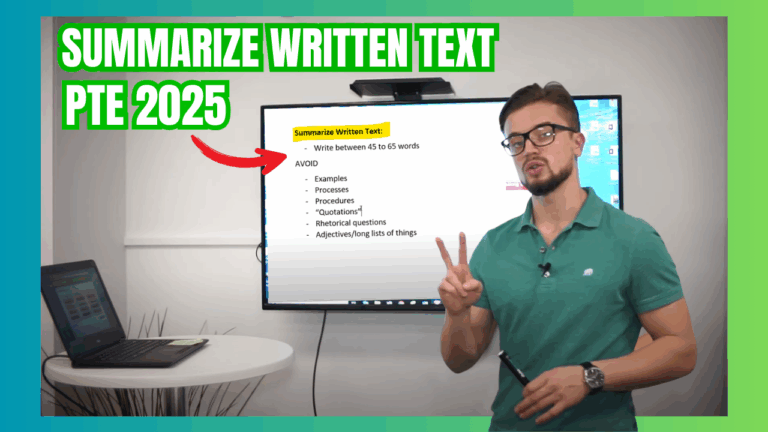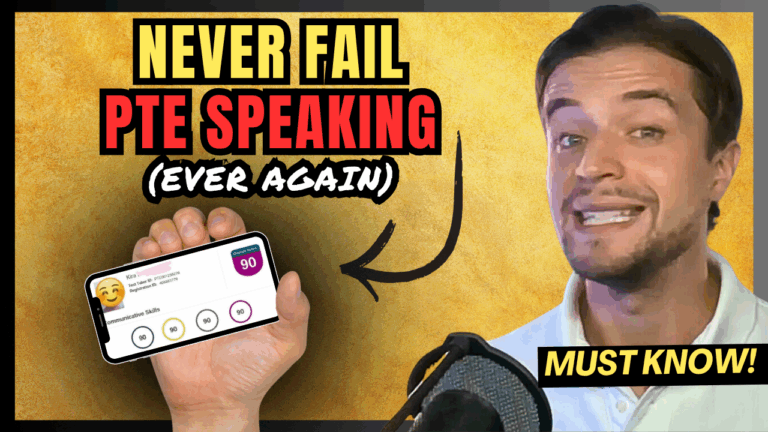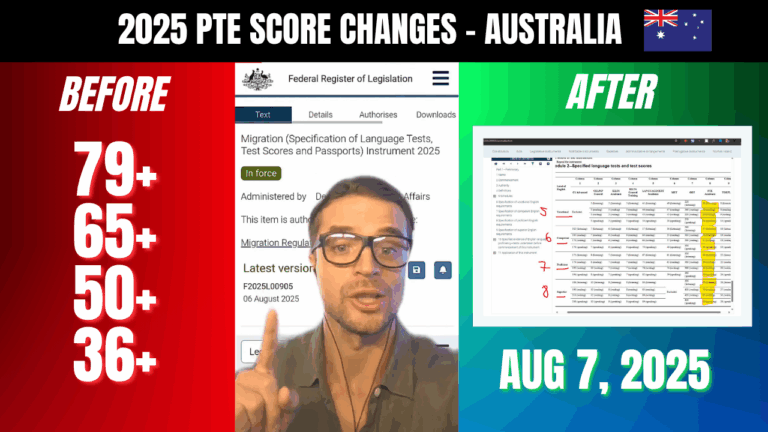PTE for Beginners: 2025 PTE Exam Format, Pattern & Tips (for each question)
So, you’ve decided to take the PTE Academic exam (Pearson Test of English). It’s a smart choice for your migration or university goals in Australia, New Zealand or your studies. But if you’re new to the test, looking at the 22 different PTE question types can feel overwhelming.
Don’t worry. This ‘PTE for Beginners Guide’ is designed to turn that confusion into confidence with the PTE Exam Patterns & Tips for each question.
We’re going to break down the entire 2-hour PTE exam, but we won’t just list the questions. For each task, we’ll give you a simple explanation, tell you the common “Beginner’s Trap” to avoid, and provide an “Expert Strategy” based on the methods we teach our successful PTE students every day.
By the end of this post, you’ll understand not just what the exam is, but how to approach it strategically.
The Two Most Important Things in PTE for Beginners to Understand
It’s a 2-Hour Computer Test: The entire exam Speaking, Writing, Reading, and Listening – is done in one session at a secure test center.
It Uses “Integrated Scoring”: This is crucial. Many tasks give you points in more than one section. For example, your performance in PTE Writing (specifically writing summaries) also gives points in your Reading score. We’ll point these out as we go.
Now, let’s break down the test, section by section.
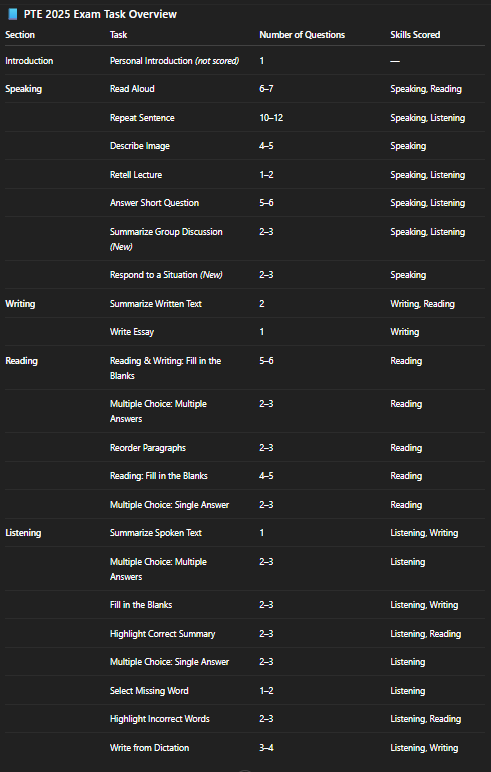
PTE Academic Exam Format 2025
Part 1: PTE Speaking Section
This is the first part of the test. Your goal here is to be clear, confident, and most importantly, fluent. The computer cares more about the continuous flow of your speech than it does about perfect grammar or complex ideas.
We have separate blog posts or videos for most of these tasks, you can typically find a link under each question.
1. PTE Read Aloud (RA)
- What it is: You’re given a short paragraph to read – first you will have 35s to prepare, and once the recording starts – you have up to 40s to read it to the computer.
- Beginner’s Trap: Pausing at every comma and reading slowly to be “perfect.” This kills your fluency score.
- Expert Strategy: Maintain a consistent, smooth pace. As we say in our classes, think of it like “scooping water, not chopping onions.” Don’t stop for mistakes; just keep going.
- Learn more here
2. PTE Repeat Sentence (RS)
- What it is: You hear a short sentence and must repeat it exactly.
- Beginner’s Trap: Panicking and trying to remember every single word. When you forget one word, you hesitate, and your score drops.
- Expert Strategy: Focus on remembering the first 5-6 words perfectly. For the rest, say what you can remember fluently. It’s better to say half the sentence perfectly than to say the whole sentence with pauses and errors.
- Integrated Scoring: This task gives you points for both Speaking and Listening.
- Learn more here
3. PTE Describe Image (DI)
- What it is: You describe the key information from a graph or image.
- Beginner’s Trap: Trying to describe every detail logically and creatively. You’ll run out of time and start hesitating.
- Expert Strategy: Use a memorized template. A good template is your safety net; it allows you to speak fluently for 30-35 seconds without having to think. You just plug in a few keywords from the image.
- Learn more here
4. PTE Retell Lecture (RL)
- What it is: You listen to a short lecture and then summarize it in your own words.
- Beginner’s Trap: Trying to write down every word you hear, resulting in messy, unusable notes.
- Expert Strategy: Again, use a template. For note-taking, focus on capturing “chunks” of ideas or key phrases, not individual words. Your goal is to have 4-5 solid points to plug into your fluent summary.
- Integrated Scoring: This task gives you points for both Speaking and Listening.
- Learn more here
5. PTE Answer Short Question (ASQ)
- What it is: You hear a simple question and give a one-word or short-phrase answer.
- Beginner’s Trap: Stressing about it.
- Expert Strategy: Don’t worry about this task. It has very little impact on your final score – as long as you TRY to give an answer (even if it’s wrong). You will at least get partial marks in your speaking section.
- Integrated Scoring: This task gives you points for both Speaking and Listening.
6. PTE Summarize Group Discussion (SGD)
- What it is: You hear a 2-2.5min conversation between 3 speakers.
- Beginner’s Trap: Trying to understand everything logically, but getting few notes.
- Expert Strategy: Don’t worry much about understanding – instead get as many notes as possible! Write the main topic at the top of your page – and below divide it into 3 sections (for speakers 1, 2 and 3).
- Integrated Scoring: This task gives you points for both Speaking and Listening.
- Learn more here
7. PTE Respond to a Situation
- What it is: You will both hear and see a 2-3 sentience situation on the screen – to which you have to respond. You are given 10s to prepare before the recording starts.
- Beginner’s Trap: Not having a plan, and making it up as you go.
- Expert Strategy: You MUST respond in 1st person (I/we/our); you must address the person properly (ex: Hi Jane…Good morning professor…. Excuse me Mr. Jones…). And if you get lost, you can always read the instructions on the screen and paraphrase those words in your own way.
- Learn more here
NOTE: the last 2 tasks above have just been added from Aug 7, 2025. We have already figured out the NEW 2025 strategies for them to score 90/90 – check it out below…
Part 2: PTE Writing Section
1. PTE Summarize Written Text (SWT)
- What it is: You read a passage and summarize its main point in a single sentence.
- Beginner’s Trap: Writing a long, complicated sentence with multiple “and” clauses, which becomes grammatically incorrect.
- Expert Strategy: Your goal is to write one, perfectly grammatical complex sentence (using words like ‘while’, ‘although’, ‘because’). Identify the main subject and the key supporting point of the passage and connect them logically.
- Learn more here
2. PTE Essay Writing
- What it is: You write a 200-300 word argumentative essay in 20 minutes.
- Beginner’s Trap: Using a common, free template found online. These are often overused and can be flagged by the Pearson AI, resulting in a low score.
- Expert Strategy: Use a proven 4-paragraph structure (Introduction, 2x Body, Conclusion). More importantly, use a template that is unique and focuses on high-level academic vocabulary and varied grammar (simple, compound, and complex sentences).
PS: we have a Blog post HERE on how to create your own, 90/90 PTE Essay Template.
Part 3: PTE Reading Section Breakdown
This is where your focus and strategy are tested. The key to a high score here is not to treat all questions equally.
1. PTE Reading and Writing Fill in the Blanks (R&W FIB)
- What it is: You read a text with dropdown menus in the gaps and select the correct word.
- Beginner’s Trap: Just guessing based on what “sounds right.”
- Expert Strategy: This is a MUST-STUDY task. It has a huge impact on your score. Practice hundreds of these questions to master grammar rules, collocations (words that go together), and context clues.
2. PTE Reading – Multiple-Choice, Multiple Answer
- What it is: You choose one or more correct answers from a list.
- Beginner’s Trap: Wasting too much time trying to find all the answers.
- Expert Strategy: Avoid this task. It has negative marking. Unless you are 100% sure of an answer, it’s better to skip it.
3. PTE Reorder Paragraph
- What it is: You drag and drop sentences to put them in the correct logical order.
- Beginner’s Trap: Trying to get the entire 4 or 5-sentence order perfect.
- Expert Strategy: Don’t aim for perfection; aim for pairs. Your score comes from correctly linking one sentence to the next. Focus on finding 1 or 2 correct pairs using logic and grammar clues.
4. PTE Reading Fill in the Blanks (R FIB)
- What it is: You drag words from a box to fill the gaps in a text.
- Beginner’s Trap: Not managing time properly.
- Expert Strategy: This is your other MUST-STUDY reading task. Along with the other FIBs, this section makes up the majority of your reading score. Practice is essential.
5. PTE Reading – Multiple-Choice, Single Answer
- Expert Strategy: Avoid this task. It has the lowest score contribution in the entire exam. Make a quick guess and move on.
- What it is: You choose only one correct answer.
- Beginner’s Trap: Spending more than 30 seconds on it.
Part 4: PTE Listening Section
This is the final section of the exam, lasting about 30-43 minutes. Your focus and energy might be low at this point, which is why time management is absolutely critical. Wasting a few extra seconds on unimportant questions at the beginning can cause you to miss the most important questions at the end. Let’s break down each task.
1. PTE Summarize Spoken Text (SST)
- What it is: You listen to a 60-90 second lecture and then have 10 minutes to write a 50-70 word summary.
- Beginner’s Trap: Trying to paraphrase everything in your own words. This often leads to losing the important keywords the computer is looking for, and you risk making grammar or spelling mistakes.
- Expert Strategy: Take notes by capturing “chunks” of 3-4 keywords at a time. Don’t try to understand the lecture deeply; just capture the key phrases. Then, use a simple template to connect these phrases together into grammatically correct sentences. Spend the last few minutes of your 10 minutes checking for spelling, grammar, and making sure you are over 50 and under 70 words.
- Integrated Scoring: This task gives you points for both Listening and Writing.
2. PTE Listening – Multiple-Choice, Multiple Answer
- What it is: You listen to a recording and select all the correct responses from a list.
- Beginner’s Trap: Getting greedy and guessing a second answer. This question has negative marking, so if you choose one correct and one incorrect answer, you get zero points for the question.
- Expert Strategy: Be safe and be fast. Read the question and options while the audio is playing. If you are 100% confident in ONE answer, select it. If not, don’t guess. Make your decision within 5-10 seconds of the audio finishing, then click next immediately.
3. PTE Listening – Fill in the Blanks
- What it is: You listen to an audio recording while reading a transcript that has several words missing. You must type the missing words.
- Beginner’s Trap: Typing the words directly into the boxes as you listen. The audio moves too fast, and you will miss the next word while you are busy typing the first one.
- Expert Strategy: Do NOT type directly into the computer. Use your erasable notebook to quickly write down the words you hear. After the audio is finished, you will have time to type your answers into the boxes. This is the safest method. Always double-check your spelling, especially for simple plurals (-s) and past tense (-ed) endings that are hard to hear.
- Learn more here
4. PTE Highlight Correct Summary
- What it is: You listen to a recording and then choose the paragraph that is the best summary.
- Beginner’s Trap: Trying to remember the entire audio from the beginning and getting confused by options that contain some, but not all, of the correct information.
- Expert Strategy: The “secret” to this question is to listen intently to the last part of the audio. The correct answer option almost always aligns with the conclusion or final point of the lecture. Match the meaning of the final 1-2 sentences of the audio to the options provided.
- Integrated Scoring: This task gives you points for both Listening and Reading.
5. PTE Listening – Multiple-Choice, Single Answer
- What it is: You listen and select only one correct answer.
- Beginner’s Trap: Wasting precious time thinking about the answer.
- Expert Strategy: This is a low-priority task. Listen and read the options simultaneously. Make your best, most logical guess and move on within 5 seconds of the audio ending. Do not waste time here.
6. PTE Select Missing Word
- What it is: The last word or phrase of an audio recording is replaced by a beep. You must select the word(s) that logically complete the sentence.
- Beginner’s Trap: Overthinking a question with very low point value.
- Expert Strategy: This is another very low-priority task. Usually, only one or two options will make logical sense. Pick the most obvious one and move on immediately.
7. PTE Highlight Incorrect Words
- What it is: You read a transcript while listening to an audio recording of that same transcript. You must click on the words in the text that are different from what the speaker says.
- Beginner’s Trap: Losing your place while listening and reading, or guessing and clicking extra words (this task has negative marking).
- Expert Strategy: Use your mouse cursor to follow the words on the screen as they are spoken. This keeps you on track. When you hear a word that is different, click the incorrect word in the text. As soon as the audio ends, click next. Don’t second-guess yourself.
- Integrated Scoring: This task gives you points for both Listening and Reading.
8. PTE Write from Dictation (WFD)
- What it is: You listen to a single sentence and must type it out exactly as you heard it, with correct spelling and punctuation.
- Beginner’s Trap: Not realizing this is the most important task in the entire Listening section and not saving enough time for it.
- Expert Strategy: This is the KING of all PTE questions. You MUST save at least 4-5 minutes on your timer for the 3-4 dictation sentences at the end. These questions are very frequently repeated, so practicing from a reliable question bank is essential. Every single word you type correctly gives you one point for Listening AND one point for Writing.
- Integrated Scoring: This gives massive points to both Listening and Writing.
- Learn more here
Your Next Step
Now you understand the PTE test format and the core strategies for a beginner. The path to success is clear: focus your energy on the high-impact tasks and use the right techniques for each one.
The best way to do this is to practice these strategies with real questions on a PTE platform that mimics the test.
👉 Access Our PTE Platform with Real Exam Questions + AI-Scored Mock Tests at: https://platform.dreamenglish.com.au
👉 For personalized PTE Coaching and feedback on your specific weaknesses, text our team on WhatsApp: +61 423 058 115
Good luck with your preparation!
Alex 🙂
PS: subscribe to our YouTube Channel for the latest PTE Tips and Tricks!
Frequently Asked PTE Questions:
Is the PTE Academic test accepted for all Australian visas?
Yes, the PTE Academic is accepted by the Australian Department of Home Affairs for all visa categories, including Student visas, Temporary Graduate visas, Skilled Migration visas (like the 189, 190, and 491), and employer-sponsored visas. It’s one of the most common ways candidates prove their English proficiency for Australian immigration.
What PTE score do I need for Australian Permanent Residency (PR)?
The score you need depends on the points you are claiming for English proficiency. For most skilled migration visas, a score of 65+ in each section gets you 10 points (Proficient English), while a score of 79+ in each section gets you the maximum 20 points (Superior English).
As you’ve seen from our student success stories, achieving 79+ can be the key to getting your invitation faster.
Are the PTE exam questions different in Australia compared to India or the Philippines for example?
No, the PTE Academic exam and its question bank are the same globally. However, the score you need is often higher for Australian purposes (like PR or professional registrations) than for university admissions in other countries. This is why practicing with a high-quality, up-to-date question bank is so important for students aiming for Australian-level scores
I’m a nurse. What PTE score do I need for my AHPRA registration in Australia?
For nursing registration with AHPRA, the standard requirement is a minimum overall score of 65 and a minimum score of 65 in each of the four sections (Listening, Reading, Writing, and Speaking). This is a common goal for many of our students, and we have specific strategies to help nurses achieve this.
Should I choose my “mother tongue” as English when booking the PTE test in Australia?
This is an important strategic choice. As I advise in my classes, if English is not your only language, you may get a slight advantage by selecting your original mother tongue. The PTE scoring system may compare your speaking patterns to other speakers of your native language, which can be fairer for your pronunciation score. We can discuss the best option for your specific background.
Where is the best place to take the PTE test in Sydney or Melbourne, or other cities/countries?
Whenever possible, it’s best to book your test at an official “Pearson Professional Center.” These centers are run directly by Pearson, and their equipment and environment tend to be the most reliable and consistent, which can help reduce test-day anxiety.
PTE Tips and Tricks (that you may also find useful)
-
PTE for Beginners: 2025 PTE Exam Format, Pattern & Tips (for each question)
So, you’ve decided to take the PTE Academic exam (Pearson Test of English). It’s a smart choice for your migration or university goals in Australia, New Zealand or your studies. But if you’re new to the test, looking at the 22 different PTE question types can feel overwhelming. Don’t worry. This ‘PTE for Beginners Guide’…
-
How to Score 90 in PTE – 2025 NEW Strategies
How to Score 90 in PTE – 2025 Tips and Tricks Scoring a perfect 90 in the PTE Academic test is not luck – it’s a formula. The PTE 2025 algorithm has changed, making fluency, timing, and realistic practice more important than ever. This complete guide is built from the Official Pearson PTE Mock Test…
-
PTE Read Aloud 2025 STRATEGIES: How to Score 90
PTE Read Aloud 2025 Strategies: How to Score 90 PTE Read Aloud is your first opportunity to establish speaking excellence and set the tone for your entire exam performance, yet most students approach it with outdated strategies that cap their scores at 70-75. If you’re targeting how to score 90 in PTE Read Aloud and…
-
The NEW Rules for 65 in PTE & 79 in PTE – (Australia Immigration PTE Score Changes)
Australia Immigration PTE score changes have completely transformed what it means to achieve your target score for visa applications. If you’re wondering “is it hard to get 65 in PTE” or “how to score 65 in PTE Academic” after the recent PTE requirement changes, you’re not alone. Hey guys, Alex here, and today I’m going…
-
PTE Listening Fill in the Blanks (5 MUST-KNOW rules & Free PDF)
What You Might Get Wrong in PTE Listening Fill in the Blanks PTE Listening Fill in the Blanks is one of the most underestimated tasks in the entire PTE exam, yet it’s costing students massive points in both listening and writing scores. In this article, we’re going to reveal the 5 CRITICAL Mistakes that literally…
-
PTE Summarize Written Text: Tips and Tricks (2025 UPDATED Strategies)
NEW Summarize Written Text Tips and Tricks So you’re here for the summarize written text tips and tricks – that’s exactly what you’ll master in this article! We’re sharing the most effective PTE Summarize Written Text (SWT) strategies that have helped thousands of students boost their PTE scores in 2025. What most people don’t know…
